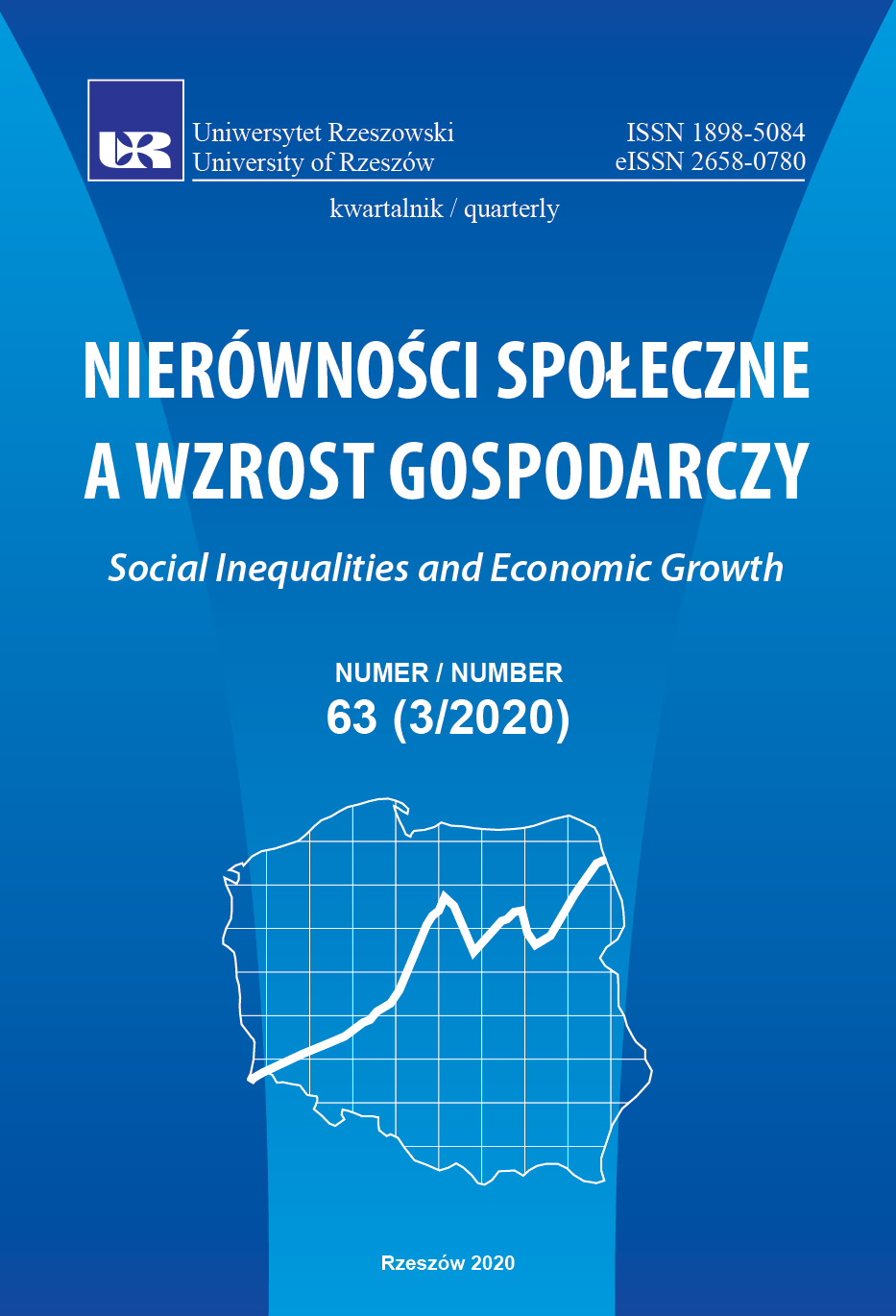The “Family 500+” programme versus the economic activity of women in Poland
DOI:
https://doi.org/10.15584/nsawg.2020.3.3Keywords:
labour market, economic activity rate, parental benefitsAbstract
The “Family 500+” programme was introduced by the Act on State Aid for Child Support. It differs from many other public programmes in that it has deeply penetrated the general awareness of Poles, which may result from the amount of the benefit, its simplicity, media coverage and the feeling that this policy directly affects people’s lives. There are comments about the impact of the programme on the condition of the labour market. It is believed that to some extent it discourages some women from taking up work, thereby potentially causing their economic activity to decline and unemployment to increase over the longer time frame. Undoubtedly, “Family 500+” is already a very large challenge for the state budget. It is highly probable that the huge funding needed to cover benefits will grow each year, constituting an important government transfer. The goal of the paper is to depict the relationship between “Family 500+” and the economic activity of women in Poland. This study is a research exercise. Quantitative methods were used, including: logistic regression modelling and Holt forecasting. The analysis suggests the conclusion that “Family 500+” has contributed to the reduction of extreme poverty in households with children but also has affected the economic activity of women in Poland, in particular younger ones, aged 25–34 years, who have low educational attainments and live in poorer voivodships. The analysis of micro data from the Human Capital Balance study has clearly confirmed that “Family 500+” negatively affects the likelihood of being economically active, which holds true not only for women at a certain age or of a certain background, but for all those surveyed.
Downloads
References
Bargu, A., Morgandi, M. (2018). Can mothers afford to work in Poland? Labor supply incentives of social benefits and childcare costs. Policy Research Working Paper No. 8295. Washington, DC: World Bank.
Białowolski, P., Dudek, S. (2016). Sytuacja na rynku consumer finance, III kwartał [Situation in the consumer finance market, 3rd quarter]. Warszawa: Konfederacja Przedsiębiorstw Finansowych w Polsce.
Central Intelligence Agency (2018). The world factbook. Retrieved from: https://www.cia. gov/library/publications/resources/the-world-factbook/ (2018.05.08).
Cohen, J. (1988). Statistical power analysis for the behavioral sciences (2nd ed.). New York: New York University. Retrieved from: http://www.utstat.toronto.edu/~brunner/ oldclass/378f16/readings/CohenPower.pdf (2018.05.08).
Ferguson, G. A., Takane, Y. (1999). Analiza statystyczna w psychologii i pedagogice [Statistical analysis in psychology and pedagogy]. Warszawa: Państwowe Wydawnictwo Naukowe.
Gromada, A. (2017). Rodzina 500+ jako polityka publiczna [Family 500+ as a public policy]. Seria Analizy Instytutu Studiów Zaawansowanych. Warszawa: Instytut Studiów Zaawansowanych.
Gruszczyński, M. (2012). Mikroekonometria [Microeconometric]. Warszawa: Wolters Kluwer.
GUS (2018a). Rocznik Demograficzny 2018 [Demographic yearbook 2018] (2018a). Warszawa: GUS.
GUS (2018b). BAEL [Study of economic activity of population]. Warszawa:GUS.
GUS (2018c). Zeszyt metodologiczny. Badanie Aktywności Ekonomicznej Ludności [Methodological notebook. Study of economic activity of population]. Warszawa: GUS.
Hosmer, D. W., Lemeshow, S. (2000). Applied logistic regression. New York: Wiley & Sons.
https://gospodarka.dziennik.pl/praca/artykuly/568094,szokujace-dane-gus-niezbedna-reforma-500-plus.html (02.03.2020).
Kisicka, A. (2017). Program „Rodzina 500 plus” w liczbach [The “Family 500 plus” programme in figures]. Retrieved from: https://www.bankier.pl/wiadomosc/Program- Rodzina-500-plus-w-liczbach-3659577.html (2018.03.27).
Kleinbaum, D. G., Klein, M. (2002). Logistic regression – a self-learning text. New York: Springer.
Kmieć, D. (2015). Zastosowanie modelu logitowego do analizy czynników wpływających na bezrobocie wśród ludności wiejskiej. Ekonomika i Organizacja Gospodarki Żyw¬nościowej, 110, 33–42.
Luici-Greulich, A., Thévenon, O. (2013). The impact of family policies on fertility trends in developed countries. European Journal of Population, 29(4), 387–416. DOI: 10.1007/s10680-013-9295-4.
Magda, I. (2018). The “Family 500+” child allowance and female labour supply in Poland. Warszawa: Wydawnictwo IBS.
Mroziński, D. (2017). Program „Rodzina 500 plus” – analiza [The “Family 500 plus” programme – An analysis]. Retrieved from: http://prostaekonomia.pl/program-rodzina-500-plus-analiza/ (2018.03.27).
Myck, M. (2016). Estimating labour supply response to the introduction of the Family 500+ programme. Szczecin: CenEA.
OECD (2018). Social Expenditure Database, the OECD Family Database, the European System of Integrated Social Protection Statistics (ESSPROS), the Comparative Family Policy Database, and the GGP Contextual Database. Retrieved from: https://www. oecd.org/social/expenditure.htm (2018.08.15).
PARP [Polish Agency for Enterprise Development] (2017). O Projekcie BKL [About the project BHC]. Warszawa: PARP.
Rudzik-Sierdzińska, A. (2017). Czy program „Rodzina 500+” wywołał efekt na rynku pracy? [Has the “Family 500+” programme had an effect on the labour market?]. Warszawa: Instytut Obywatelski.
Skoczypiec, S. (2012). Metody prognozowania. Jakość prognoz [Forecasting methods. Quality of forecasts]. Retrieved from: http://m6.pk.edu.pl/materialy/mp/MP_02_ bledy_prognozy.pdf (2018.03.02).
Szarfenberg, R. (2018). Przewidywane skutki społeczne 500+: ubóstwo i rynek pracy [Expected social consequences of 500+: Poverty and the labour market]. Warszawa: Zgromadzenie Ogólne Polskiego Komitetu Europejskiej Sieci Przeciwdziałania Ubóstwu, EAPN Polska.
Ustawa z dnia 11 lutego 2016 r. o pomocy Państwa w wychowaniu dzieci, Dz. U. z 2017 r., poz. 1851.
Downloads
Published
How to Cite
Issue
Section
License
Copyright (c) 2020 University of Rzeszow

This work is licensed under a Creative Commons Attribution-ShareAlike 4.0 International License.


